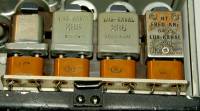en:frequency_memories
Frequency memory
The need to store frequencies of other stations in a networek has existed since the beginning of wireless communications.
Originally, it was only possible to write down the frequency reading on the more or less inaccurate frequency dial; many sets had a logging dial for this purpose, the numerical value read on the 0 - 100 dial was recorded on a log table.
- Fixed frequency receivers: For the reception of only one station on a fixed frequency, fixed frequency receivers were sufficient. These sets used for example a crystal to be set to one frequency and could not be tuned to different frequencies. This kind of sets was used e.g. in press agency and weather fax receivers in commercial radio stations.
- Mechanical frequency detents: in early military equipment, mechanical frequency detents were used to move the mechanical dial pointer between two mechanical stops, allowing to set an upper and lower operation frequency. Examples include early aircraft sets.
- Mechanical frequency setting units: there are rare examples of mechanical frequency setting units that allowed a number of frequencies to be preset and recalled at the touch of a button. These motor driven sets can be found in early aeronautical wireless applications and military equipment. The personnel had to mechanically pre-tune the frequencies, but the pilot on his plane could simply push a button to change the frequency channel.
- Crystal controlled frequency presets: also in aeronautical and military applications, there have been sets with a number of quartz crystals to control the frequency. This are not too difficult to design, but expensive, as a hole selection of expensive crystals is needed to cover a certain number of frequencies. U.S. Army sets came with a crystal box full with crystals for the different channels.
- Frequency storage with multi-turn potentiometers: in some „world receivers“, frequencies could be preset with multi-turn potentiometers that preset the tuning voltage. Channels were stored in a similar way in older television sets.
- Digital frequency memories: With the introduction of PLL synthesis technology, it was also possible to store frequencies in digital form using digital memory chips. For this, it's mandatory that the digital frequency information can be used to control the processor of the receiver's PLL unit. Initially, a memory unit with four frequency memories could have a price tag of US$1000 and had to be purchased as an external accessory, but a few years later, hundreds of frequency memory channels were available in simple microprocessor-controlled scanning receivers, the sheer number of the memories made it difficult to keep track of the memory content. Alphanumeric memories allow to label the frequency information with the name of the station.
en/frequency_memories.txt · Zuletzt geändert: 2021/04/17 12:00 von mb


